Language and Literacy Development
Language and Literacy Development. Purpose of language. The purpose of language is, of course, communication. Language’s purpose has a lot to do with how the ability to use language develops in people. The cycle of language development.
Share Presentation
Embed Code
Link
Download Presentation
- sure what behaviorism
- early word
- praxis ii plt
- language development
- right ballpark
- so many

noreen + Follow
Download Presentation
Language and Literacy Development
An Image/Link below is provided (as is) to download presentation Download Policy: Content on the Website is provided to you AS IS for your information and personal use and may not be sold / licensed / shared on other websites without getting consent from its author. Content is provided to you AS IS for your information and personal use only. Download presentation by click this link. While downloading, if for some reason you are not able to download a presentation, the publisher may have deleted the file from their server. During download, if you can't get a presentation, the file might be deleted by the publisher.
Presentation Transcript
- Language and Literacy Development
- Purpose of language • The purpose of language is, of course, communication. Language’s purpose has a lot to do with how the ability to use language develops in people.
- The cycle of language development • Language development is a cycle (really a spiral, since each go-round leads to greater competency). • The cycle works as both a positive and a negative feedback system. Attempt to communicate Reception
- Understanding the cycle • Children attempt to communicate and their communication is received either successfully (positive feedback) or unsuccessfully (negative feedback). • Think of the baby who happens to babble “mamamamamama” in front of his/her maternal parent. What does the parent say. “You said ‘mama’. ” This is an example of when the child’s approximation of language is acceptable to the listener and the listener gives a whole lot of positive feedback. This positive feedback encourages the child to try again and to try more words.
- Understanding the cycle • Sometimes the child’s attempt to communicate is met with a negative reception. For example, some children have idiosyncratic language. For example, my niece used to call raisins “winkies,” for some unknown reason. Within the family, that was okay. We all knew what she was talking about. But someone outside the family would not have understood her. When a child’s attempt to communicate is not understood, the child receives negative feedback. This encourages the child to learn to speak the same way that other people speak. In my niece’s case, she learned the “correct” name for raisins.
- Approximations • What is critical is to remember that babies are not capable of pronouncing words correctly. So they have to do something that is an approximation. It is in the right ballpark, maybe, but it is not the same way an older child might pronounce the same word. You might want to ask your parents about your own early language development and find out how you approximated words as a baby.
- Approximations • Over time, children’s approximations of language become better and better through the feedback cycle. The positive feedback encourages them to keep trying. The negative feedback encourages them to make their approximations better.
- Understanding the cycle • Children’s language evolves using this cycle toward more effective, e.g., conventional communication.
- Conventionality • The concept of conventionality is critical to understand. • Language is “conventional,” in the sense that there are certain practices that all competent language users adopt—conventions. We may each say unique things but we do so using syntax (word order/grammar) that is conventional. Otherwise we risk the possibility that our unique message may not be understood.
- Conventionality • Babies do not start off using conventional language, but through social interactions (the feedback cycle), they develop the ability to use conventional language. For example, children tend to overgeneralize the –ed ending for past tense and say “I goed to the store yesterday” or “I putted my toys back” instead of “I went” or “I put my toys back.” Through that cycle of feedback, they learn to use the correct versions of the words they hear.
- Conventionality • Children’s inventions of this sort indicate that language is not “taught” to children. Children do not merely imitate what they hear. They take what they know and construct new meanings. The behaviorists are wrong about language development (they were the ones that thought that children merely imitated what they heard). If the behaviorists were right, children would not overgeneralize rules—instead, they would say only what they had heard said. Children don’t hear adults saying “goed” or “putted.” But many children invent these words when they need to express the past tense of “to go” or “to put.”
- Behaviorists • Take a moment to reflect on what you know about behaviorism—you will need this information for Praxis II PLT. If you are not sure what behaviorism is, then review your Ed. Psych book and the Praxis documents on Blackboard for this class.
- Conventionality • Similarly, my brother invented the word “chandles” to explain that a lightbulb had burned out of the ceiling fixture. He knew that candles went in candlesticks, so chandles must go in chandeliers. He was quite upset when no one understood what he was saying (and then more upset when my mother thought it was cute and reported it to everyone she knew). This is a good example of how the social context helps children become more conventional in their language use.
- Language and desire • Where does the drive to use language come from? • Basically, language development comes from a drive to solve problems, to meet one’s own desires and needs.
- Language and desire • Think about how and why babies communicate. • They begin by crying. But does this work? A baby’s cry can mean so many different things: I’m hungry, I’m tired, My diaper needs to be changed, I’m bored, I’m scared, I have a belly ache because you didn’t burp me correctly, my ear hurts.
- Language and desire • So what the parents do is that they frantically rush around trying to figure out why the baby is crying. Check the diaper, check to make sure nothing is pinching, try the bottle, try putting the baby to bed, check for a fever, etc. • It can sometimes take a long time for a parent to address the needs of the baby because crying is fairly nonspecific. This is an impetus for developing language.
- Language and desire • Babies are immersed in language, surrounded by people who are more competent than they but also by people who speak “parent-ese,” and who scaffold a baby’s language development. That is what is happening when people speak babytalk to babies: “Oh, ooo cute wittle fing. Ooo so cute. I wuv ooo.” See how this is a simplified form of English? It contains approximations of consonant sounds that children find difficult to make, such as the letter L or the TH sound.
- Language and desire • This is a type of scaffold—show the child an acceptable approximation. It’s fine when a two year old substitutes a W sound for the L sound or F for TH. By the time the kid is five or six, he or she will have a more conventional way of pronouncing words or else the kindergarten teacher will refer the child for speech therapy.
- Scaffold • A scaffold is a method of making a task more doable for learners by reducing its complexity. For example, vibrato is a complex skill for violinists to develop. Often students have difficulty wiggling the left hand while keeping the right hand (bow arm) from wiggling. One scaffold is for the teacher to bow the student’s violin while the student is practicing the vibrato. The student learns the essential part of the skill and then is able to learn all the parts (bowing and doing vibrato simultaneously).
- Scaffold • When you are thinking of scaffolding, look at the task and see if you can take it apart. Ask the child to do just one part of it while someone else (you or a more advanced peer) does the other part of it. Later the child will be able to do the whole thing him or herself. • Remember Vygotsky in connection with scaffolding, when it comes to Praxis II PLT.
- Babbling • One of the first stages of linguistic development is babbling. Children “try out” their voices and play with the noises they can make. During the first part of babbling, they use all the phonemes of all the human languages in the world. Later on, they only use the phonemes in their home language(s). • Children in homes where people use American Sign Language babble with their hands (isn’t that neat!!).
- Babbling • The feedback process and scaffolding are at work during this critical stage. One critical thing that parents do is to imitate what the baby says. Babies this age think this is very funny. They say “babababa” and you say the same thing. They will do this over and over again, which is how they practice. This type of exchange encourages them to try and imitate you.
- Babbling • The approximation part of the cycle begins during babbling. This is when parents signal through positive feedback that they are excited about the child’s attempts to communicate. It is during the babbling stage that parents “recognize” certain words, whether or not that was the child’s intent. This is how we learn to speak.
- Children’s linguistic development • After the babbling state, babies use single words to communicate at first. The first words of a baby are always things that are important in their lives. So each child has a different vocabulary. Kids who live with mom and dad usually but not always have those names as first words. Children who live with pets will often have the name of the pet as an early word. There may be an object that is somehow important to the child and that becomes an early word.
- Children’s linguistic development • These single words are actually a kind of shorthand for a longer thought. The single word “doggie” may mean “look, Mommy, there is a dog” or “the dog is scaring me” or “I want my doggie.” • You can see that single words are far better than crying for communicating with parents. At least with a single word, the child can give a pretty good hint about where the problem lies.
- Children’s linguistic development • But single words are not completely effective as a means of communication. Parents can’t always figure out what the problem is with just one word as a hint. The ambiguities in meaning lead to the next stage, two word sentences or telegraphic speech.
- Children’s linguistic development • In the old days, when people sent telegrams, they had to pay for each word they sent. So they left out the connecting words: ARRIVING COLUMBUS 3:45. GREYHOUND. • That was cheaper than, “I will be arriving in Columbus at 3:45 by Greyhound bus.” • Children usually put together two word sentences: “Mommie cookie.” This might mean “Mommie, give me a cookie” or “Mommie is eating a cookie.”
- Children’s linguistic development • Two words together communicates a lot more effectively than a single word. Yet still misunderstandings can happen and those misunderstandings that are a part of the social context of language help the child move toward conventionality and gaining a larger vocabulary. • Finally, by the time a child is about three years old, he or she is speaking in whole sentences across a whole range of verb tenses. It’s really amazing how quickly children master language, when you consider that they are born helpless and with no language.
- Literacy development • Literacy, to a certain extent, is artificial. It is a visual representation of something that is aural (like the written version of music). Because of its artificiality, literacy development is typically learned in a more formal way than linguistic development. It is more difficult to develop and that development takes place at a later stage in life than linguistic development. That said, there are lots of ways in which literacy development parallels linguistic development.
- Literacy development • Literacy development is an extension of oral language development. It follows a parallel path that is characterized by approximations of adult forms; these approximations move toward conventionality within the social context and over time.
- Writing development Like oral language, children’s written language moves through stages: • Scribbling (like babbling) • Random letters and pretend letters (often using the letters of their own name if they know these) • Initial sound of the word • Initial sound plus other sounds • Representation of all sounds • Understanding of spelling rules—conventional writing
- Reading development • Reading can also be approximated—through a child picking up a book she has memorized, or through reading a predictable book that has illustrations (Brown Bear, for instance). Children might approximate reading by imitating literate behaviors such as turning the pages appropriately, pointing at words, using the pictures to create a story, and so forth.
- Reading development • As children start to develop phonological awareness (understandings of letter-sound correspondences) they can begin to “sound out” words. They are often taught by teachers to use other cues as well, such as looking at the pictures to check their meaning.
- Reading development Common reading strategies that teachers teach children: • Try the first letter (for emergent readers) or sound it out (for children with more experience) • Figure out what word would make sense in the sentence • Look at the picture • Re-read with your guess to see if it makes sense.
- So, what do you need to remember? • Literacy is an extension of orality. That means that there are parallels in the way literacy and orality are learned. • The social context is central to the learning of orality and literacy. How much did you learn about writing just copying things from the board or writing papers that only the teacher saw? Those are examples of literacy that is removed from the social context. In contrast, when there is a connection to social context, children learn more. Many teachers have found lots of ways of making writing and reading social experiences.
- More stuff to remember • Just as every child has a different initial vocabulary, every child will have a different process of learning to read. • Learning to read involves epiphanies—that sudden connection of the sight of a word with its sound and meaning. We never know which experience will lead a child to this epiphany, so we must give them many opportunities • Children approximate and then become conventional through the social experiences over time. You will probably see evidence of this in your classroom.
- Questions for you • What parallels do you see between language/literacy development and musical development in children? • How might you scaffold children’s musical abilities?
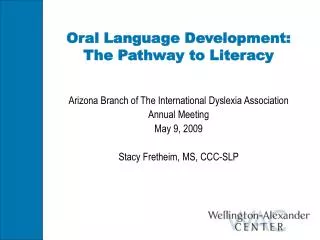
Oral Language Development: The Pathway to Literacy
Oral Language Development: The Pathway to Literacy Arizona Branch of The International Dyslexia Association Annual Meeting May 9, 2009 Stacy Fretheim, MS, CCC-SLP Definition of Language Language is a code made up of rules including how to make words what words mean
569 views • 13 slides

Oral Language Development: The Pathway to Literacy
Oral Language Development: The Pathway to Literacy. Arizona Branch of The International Dyslexia Association Annual Meeting May 9, 2009 Stacy Fretheim, MS, CCC-SLP. Definition of Language. Language is a code made up of rules including how to make words what words mean
350 views • 13 slides
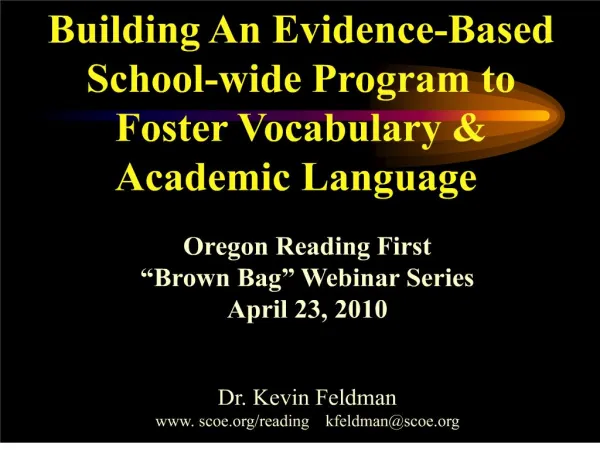
matthew effects in academic language and literacy development
GOALS for Today. 1.) Validation/Motivation2.) Clarity on how to create an
555 views • 32 slides
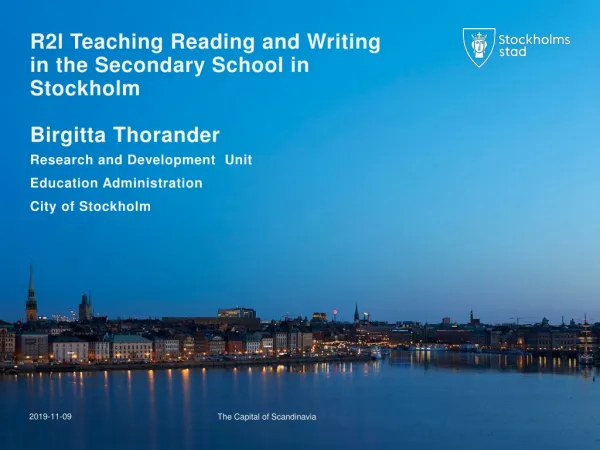
Language and literacy resources
R2l Teaching Reading and Writing in the Secondary School in Stockholm Birgitta Thorander Research and Development Unit Education Administration City of Stockholm. Language and literacy resources. Curriculum goals. Language and literacy Resources + L1 speakers.
339 views • 9 slides
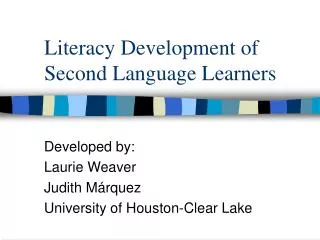
Literacy Development of Second Language Learners
Literacy Development of Second Language Learners. Developed by: Laurie Weaver Judith M á rquez University of Houston-Clear Lake. Activity. First, read the paragraph on the following slide to yourself.
965 views • 29 slides

Language and Literacy
Painting the Picture. Over 1/3 of the children in the US enter school unprepared to learn (Whitehurst)They lack oral language (vocabulary knowledge, syntactic knowledge, narrative understanding) or print knowledge or phonological processing or a combination. . Painting the Picture. Children's emergent literacy skills are highly stable -- indicating that children who start behind are likely to stay behind. There are effective interventions for improving children's emergent literacy skills..
1.1k views • 43 slides
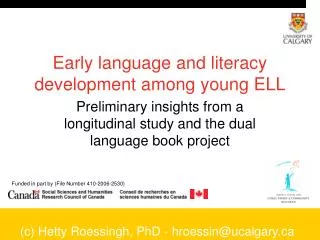
Early language and literacy development among young ELL
Early language and literacy development among young ELL. Preliminary insights from a longitudinal study and the dual language book project. Funded in part by (File Number 410-2006-2530). Purpose.
563 views • 24 slides

Speech, Language and Literacy
Early Sound and Language Development. Children are exposed to and begin to learn sounds and language from the day they are born.Infants use cries to gain attention and to communicate. Adults quickly can differentiate a cry requesting a bottle vs. a cry of pain vs. a cry demanding to be held.As ch
249 views • 9 slides
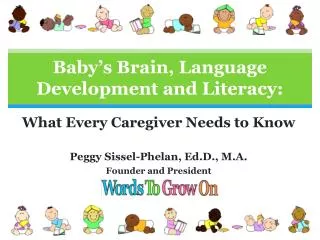
Baby’s Brain, Language Development and Literacy:
Baby’s Brain, Language Development and Literacy:. What Every Caregiver Needs to Know Peggy Sissel-Phelan, Ed.D ., M.A. Founder and President. Introduction. Brain development from birth to age three Language development Emergent literacy skills and school readiness;
562 views • 36 slides
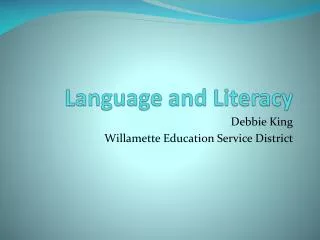
Language and Literacy
Language and Literacy. Debbie King Willamette Education Service District. Today’s Agenda. What is early literacy? What early literacy is not Language and literacy Stages of early literacy and language Developmental activities for literacy Practice!. What is early literacy.
711 views • 22 slides
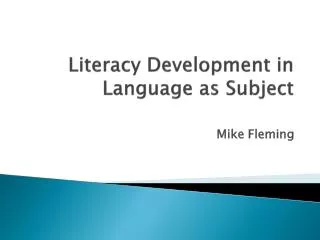
Literacy Development in Language as Subject
Literacy Development in Language as Subject . Mike Fleming. Outline. Changing ideas about literacy development in language as subject Tensions Relationship between language as subject and language in other subjects . Changing ideas. Traditional Moving On Maturing. Traditional.
340 views • 17 slides
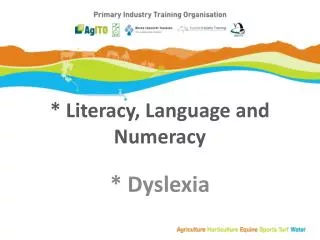
* Literacy, Language and Numeracy
* Literacy, Language and Numeracy. * Dyslexia. On the menu. Summary of ALNAT data to date – some common problems Some strategies to address the problems above
721 views • 21 slides
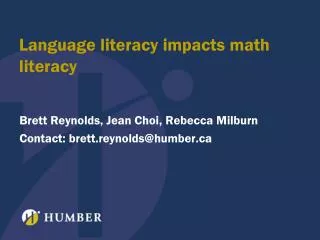
Language literacy impacts math literacy
Language literacy impacts math literacy. Brett Reynolds, Jean Choi, Rebecca Milburn Contact: brett.reynolds@humber.ca. From an article in College Reading 3.
329 views • 20 slides
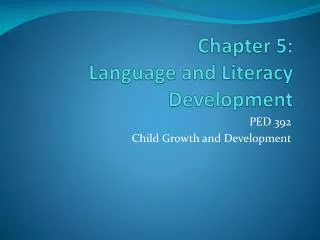
Chapter 5: Language and Literacy Development
Chapter 5: Language and Literacy Development. PED 392 Child Growth and Development. Definitions. Language A symbolic system: a series of sounds or gestures in which words represent an idea, object or person Literacy
319 views • 17 slides

Language, Literacy and Numeracy
What do you think Language, Literacy and Numeracy is? How do you think it contributes to wellbeing?. Language, Literacy and Numeracy. Ataneta Paewai, Janet Te Rore, Sandi Elers, Serenah Nicholson, and Toni-Lee Hayward Atawhai Li of Eastbay REAP,
409 views • 14 slides
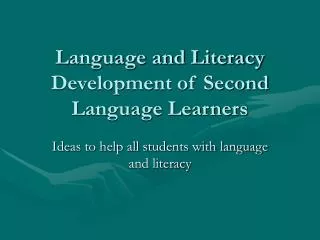
Language and Literacy Development of Second Language Learners
Language and Literacy Development of Second Language Learners. Ideas to help all students with language and literacy. Stages of Language Acquisition. Silent Period 6 months Early Speech 6-12 months Intermediate Speech 12 months Advanced Speech 12 months
446 views • 12 slides
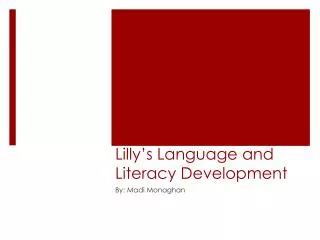
Lilly’s Language and Literacy Development
Lilly’s Language and Literacy Development. By: Madi Monaghan. Apple Tasting Unit. Teacher Example. Lilly’s Replication. Lilly’s list of our friends in the class who were at school that day. Samples of Lilly’s free play artwork. More artwork from Lilly’s free play.
204 views • 7 slides
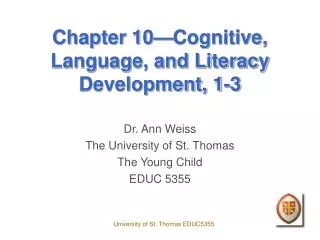
Chapter 10—Cognitive, Language, and Literacy Development, 1-3
Chapter 10—Cognitive, Language, and Literacy Development, 1-3. Dr. Ann Weiss The University of St. Thomas The Young Child EDUC 5355. What is Language Development?. Children learn language as they interact with responsive adults and peers and experience language use in meaningful contexts.
612 views • 12 slides

Language, Talk and Literacy Development & Early Literacy
Language, Talk and Literacy Development & Early Literacy. Is an auditory skill that doesn’t have to involve print Activities are auditory Focuses on how sounds can be segmented, combined, and manipulated in spoken language Begins before children sound-letter correspondences by manipulating them.
467 views • 17 slides
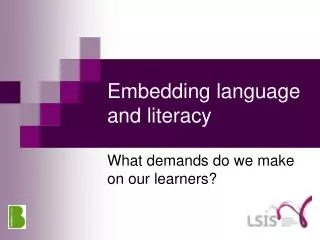
Embedding language and literacy
Embedding language and literacy. What demands do we make on our learners?. Embedded LLN.
261 views • 13 slides
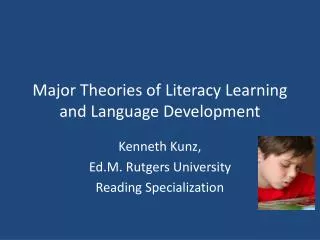
Major Theories of Literacy Learning and Language Development
Major Theories of Literacy Learning and Language Development. Kenneth Kunz, Ed.M. Rutgers University Reading Specialization. What is Behaviorism?. Learning consists of the acquisition of new behaviors. Stimulus vs. Response Skinner’s Learning Theory Operant conditioning
912 views • 13 slides

Communication Language and Literacy Development
Communication Language and Literacy Development. Letters and Sounds Working on Phase 5. Aims. To develop subject knowledge of the alphabetic code when working on Phase 5 To develop systematic and cumulative planning of Phase 5 over a week
943 views • 72 slides
























